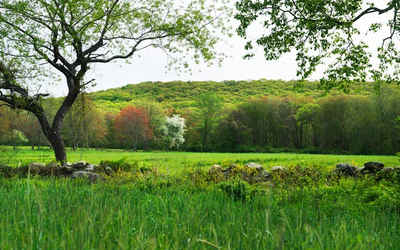Rhode Island State Fruit
Rhode Island Greening Apple

(Malus domestica)
Adopted in 1991.
The Rhode Island Greening Apple, (Malus domestica,) was adopted as Rhode Island's state fruit in 1991.
The fruit is juicy, tart, and distinctively flavored, excellent for both cooking and eating, with smooth, oily skin. When fully ripe on the tree, the skin becomes yellower and the flesh sweeter. They have a sharp taste retained during cooking so they are perfect for apple pies and apple slumps. Slumps (or grunts in Massachusetts) are stewed fruits topped with a dumpling.
Rhode Island State Fruit
Rhode Island Greening Apple

The 'Rhode Island Greening' allegedly originated around 1650 near Green's End in Newport, Rhode Island (in modern day Middletown) . The first Greenings were allegedly grown by a Mr. Green who operated a tavern and developed apple trees from seed. Green gave many scions from the tree to visitors for grafting elsewhere, and the original tree died. The apples became known as 'Green's Inn' apples from Rhode Island. One of the oldest surviving trees was located on Mt. Hygeia farm in Foster, Rhode Island, at the turn of the 20th century. The 'Rhode Island Greening' was one of the most popular apples grown in New York in the 19th century.
The first orchard in Massachusetts was planted around 1625 by a clergyman named William Blaxton who owned a farm on Beacon Hill in Boston. He later moved to Pawtucket, Rhode Island and planted the first Rhode Island orchard in 1635. Blaxton is credited for having grown the first named apple in America. Apples are frequently named after the owner or location of origin. Blaxton named his apple Blaxton's Yellow Sweeting but it was latter referred to as Sweet Rhode Island Greening. Unlike today, these early orchards were planted with imported seeds rather than grafted trees.
Characteristics of the Rhode Island Greening Apple

This medium-size, green to yellow green apple has a sweet-tart flavor that seems to intensify when cooked. Because both texture and flavor hold up to heat, most of the Rhode Island greening crop is sold for commercial processing (applesauce, pies, etc.). It's also good for out-of-hand eating and is available from October to April, mainly in the eastern and central United States A variant grown in the western half of the country is called Northwest Greening.
Leaf: Opposite, 3 to 5 palmate lobes with serrate margins, sinuses relatively shallow (but variable), 2 to 4 inches long; light green above, whitened and sometimes glaucous or hairy beneath.
Flower: Appear March to May, usually before leaves; usually bright red but occasionally yellow.
Fruit: Clusters of 1/2 to 3/4 inch long fruit with slighly divergent wings, appear May to June, on long slender stems. Light brown and often reddish.
Twig: Reddish and lustrous with small lenticels, buds usually blunt, green or reddish (fall and winter) with several scales usually present, leaf scars V-shaped, 3 bundle scars, lateral buds slightly stalked, may be collateral buds present.
Bark: On young trees, smooth and light gray, with age becomes darker and breaks up into long scaly plates.
Form: Medium-sized tree. In forest, trunk usually clear for some distance, in the open the trunk is shorter and the crown rounded.
Rhode Island Law
The law designating the Rhode Island greening apple as the official Rhode Island state fruit is found in the State of Rhode Island General Laws, Title 42, Chapter 1042-4, Section 42-4-13
TITLE 42 State Affairs and Government
CHAPTER 42-4 State Emblems
SECTION 42-4-13
§ 42-4-13 Official state fruit. - The variety of apple known as the Rhode Island greening is hereby designated as the official state fruit for the
state.
Taxonomic Hierarchy: Rhode Island Greening
Kingdom: Plantae - Plants
Subkingdom: Tracheobionta - Vascular plants
Superdivision: Spermatophyta - Seed plants
Division: Magnoliophyta - Flowering plants
Class: Magnoliopsida - Dicotyledons
Subclass: Rosidae
Order: Rosales
Family: Rosaceae - Rose family
Genus: Malus Mill. - apple
Species: Malus pumila P. Mill. - paradise apple
Cultivar: Rhode Island Greening

List Official US State Foods







